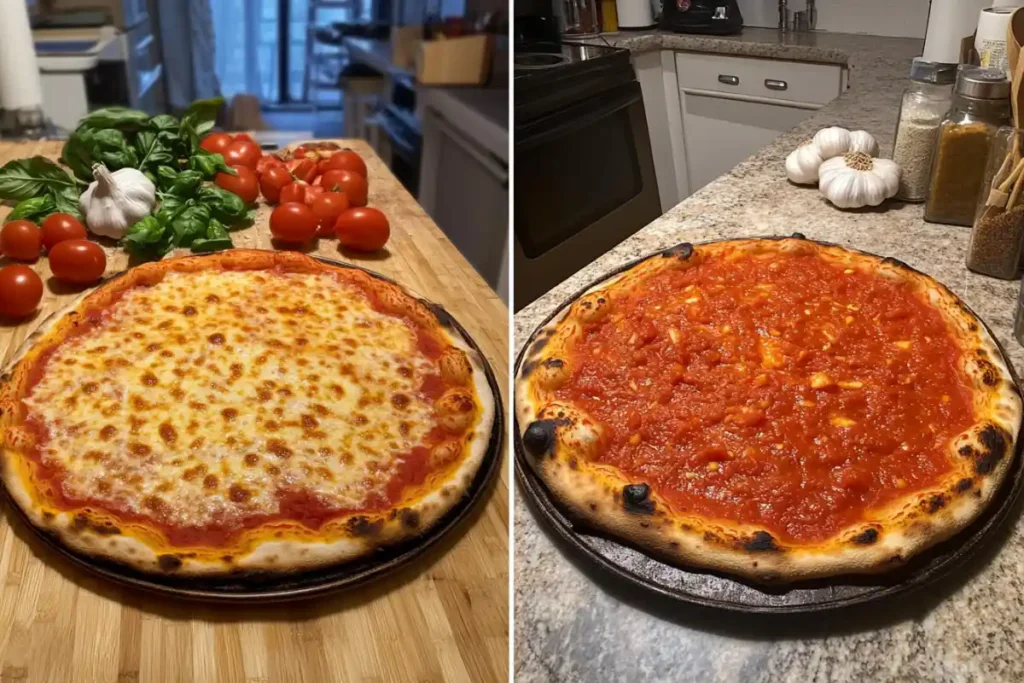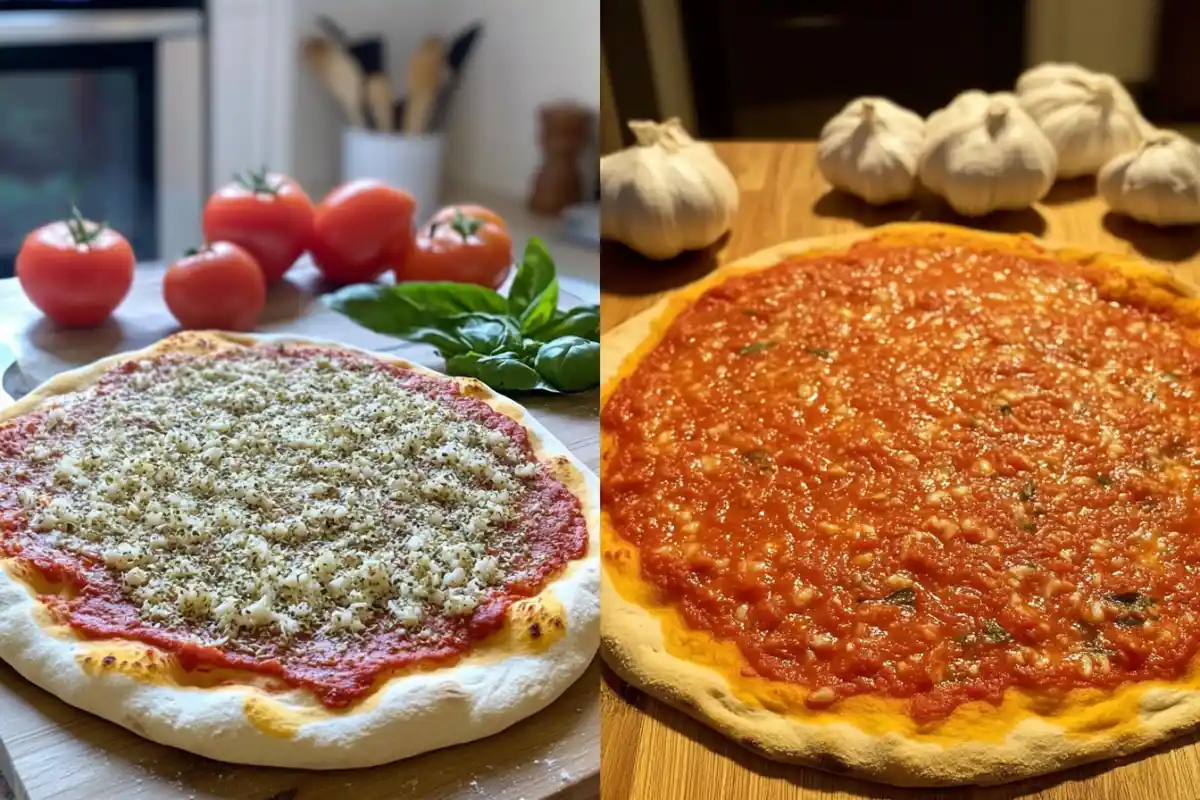Introduction to Cook Tomato Sauce for Pizza
Pizza is a universal favorite, but the secret to a truly unforgettable pizza lies in its sauce. A well-prepared tomato sauce elevates the flavors of every topping and perfectly complements the crust. Learning to cook tomato sauce for pizza at home provides you with the freedom to experiment with flavors, ensuring a sauce that’s tailored to your taste buds. This guide dives deep into the essentials of creating the perfect sauce, from selecting the best ingredients to achieving the right consistency.
Why is the sauce so crucial? The answer lies in its versatility and ability to bind all the elements of a pizza together. While toppings and crust vary widely, a good sauce acts as the flavorful glue, enhancing the entire dish. Whether you’re crafting a classic Margherita pizza or experimenting with unconventional toppings, mastering your sauce is the first step toward pizza perfection.
Choosing the Right Tomatoes
Fresh vs. Canned: Which is Better?
The foundation of any great tomato sauce is, of course, the tomatoes themselves. You can choose between fresh tomatoes and canned tomatoes, but understanding their unique qualities will guide your decision:
- Fresh Tomatoes:
- Perfect for summer when tomatoes are at their peak.
- Provide a bright, slightly tangy flavor.
- Require peeling, seeding, and longer preparation time.
- Canned Tomatoes:
- Consistent flavor, especially in off-seasons.
- San Marzano tomatoes are highly recommended for their rich, sweet taste and low acidity.
- Convenient and require minimal prep.
For authentic pizza flavors, many chefs prefer canned tomatoes, particularly those labeled “San Marzano.” These tomatoes are grown in the volcanic soil of Italy, giving them an unmatched flavor profile.
Essential Ingredients for Cooking Tomato Sauce for Pizza
When it comes to crafting a pizza sauce, simplicity is key. Fewer ingredients allow the tomato’s natural flavors to shine. Here’s what you’ll need:
Here’s the table with quantities included where applicable:
| Quantity | Ingredient | Purpose |
|---|---|---|
| 1-2 cups | Tomatoes (crushed or pureed) | Provides body and flavor for the sauce |
| 2-3 cloves | Garlic (minced) | Adds a warm, aromatic base |
| ¼ cup (optional) | Onions (finely chopped) | Contributes natural sweetness |
| 2 tablespoons | Olive oil | Enhances richness and acts as a flavor carrier |
| 1 teaspoon each | Dried oregano and basil | Classic Italian profile |
| To taste | Fresh herbs (e.g., basil, parsley) | Adds a burst of fresh flavor |
| 1 teaspoon | Salt | Balances overall flavor |
| ½ teaspoon | Black pepper | Adds mild heat and depth |
| 1 teaspoon (optional) | Sugar | Balances acidity |
| ¼ teaspoon (optional) | Red pepper flakes | Adds heat |
| 1 teaspoon (optional) | Balsamic vinegar | Adds depth |
| 1 small piece (optional) | Parmesan rind | Adds umami |
The Role of Each Ingredient
Tomatoes
Tomatoes are the star of this sauce. Whether you use canned or fresh, ensure they are ripe and flavorful. San Marzano tomatoes are ideal for their natural sweetness and balanced acidity.
Aromatics
- Garlic and Onions: These create a flavor base for the sauce. Sautéing them in olive oil enhances their natural sweetness and adds a depth of flavor.
Herbs and Seasonings
- Dried Oregano: Brings out classic pizza flavors.
- Fresh Basil: Added at the end of cooking, basil ensures a vibrant finish.
- Salt, Pepper, and Sugar: These balance the sauce, ensuring it isn’t overly acidic or bland.
Olive Oil
Extra virgin olive oil adds a layer of richness, making the sauce smooth and luxurious. It also acts as a carrier for the herbs and spices, distributing their flavors evenly throughout the sauce.
Equipment Needed to Cook Tomato Sauce for Pizza
Preparing a perfect pizza sauce doesn’t require fancy tools, but having the right equipment can make the process smoother:
- Saucepan or Pot: For simmering the sauce.
- Blender or Food Processor: To achieve a smooth consistency.
- Wooden Spoon: For stirring the sauce during cooking.
- Sieve or Strainer: To remove seeds and create a velvety texture.
Why Make Your Own Pizza Sauce?
While store-bought sauces offer convenience, they often fall short on flavor and freshness. Homemade pizza sauce not only tastes better but also allows you to control the ingredients, avoiding unnecessary preservatives and additives. Plus, making your sauce can be a fun, creative process that fills your kitchen with the irresistible aroma of simmering tomatoes, garlic, and herbs.
By learning to cook tomato sauce for pizza, you’re not just creating a delicious base—you’re laying the foundation for an authentic pizza-making experience. With a little practice, your homemade sauce can rival the best pizzerias.
Step-by-Step Guide to Cook Tomato Sauce for Pizza
Creating the perfect pizza sauce requires patience and attention to detail. Follow these steps to ensure your sauce has the ideal balance of flavor, texture, and consistency.
Preparing the Tomatoes

Fresh Tomatoes
If you’re using fresh tomatoes, prepare them carefully to bring out their best qualities:
- Blanching: Boil the tomatoes briefly, then plunge them into ice water. This makes it easier to remove the skins.
- Peeling and Seeding: Peel off the skin and cut the tomatoes in half. Remove seeds to reduce bitterness and ensure a smooth sauce.
- Chopping or Crushing: Chop the tomatoes into small pieces or crush them for a chunkier sauce.
Canned Tomatoes
Canned tomatoes are already peeled and processed, making them a time-saving option. For the best results:
- San Marzano Tomatoes: Choose these for their sweet, rich flavor.
- Preparation: Simply crush the tomatoes by hand or blend them lightly for a smoother consistency.
For a more detailed comparison between fresh and canned options, refer to this resource on tomato preparation.
Sautéing Aromatics
Aromatics like garlic and onions create a flavor foundation for your sauce.
- Heat the Oil: Add a generous drizzle of olive oil to a saucepan and warm over medium heat.
- Sauté Garlic and Onions:
- Cook finely chopped onions until they become translucent.
- Add minced garlic and sauté until fragrant, ensuring they don’t brown as this could make the sauce bitter.
- Infuse the Herbs: At this stage, you can add dried herbs like oregano or thyme to the oil. Heating the herbs enhances their aroma and flavor.
Combining Ingredients to Cook Tomato Sauce for Pizza
Once your aromatics are ready, it’s time to combine everything.
- Add Tomatoes: Pour in your prepared fresh or canned tomatoes.
- Season the Sauce:
- A pinch of salt to enhance the natural flavors.
- A dash of sugar to balance acidity.
- Freshly ground black pepper for depth.
- Optional Additions:
- Red pepper flakes for heat.
- A splash of red wine for a more robust flavor.
To experiment with variations, explore this guide to enhancing tomato sauces.
Simmering the Sauce to Perfection
Simmering is the key to developing deep, rich flavors. This step transforms simple ingredients into a cohesive, flavorful sauce.
- Bring to a Boil: Increase the heat briefly to bring the mixture to a boil.
- Reduce Heat and Simmer:
- Lower the heat and allow the sauce to simmer gently.
- Stir occasionally to prevent sticking and ensure even cooking.
- Cooking Time: Let the sauce simmer for 20–30 minutes. This allows the flavors to meld and the sauce to thicken naturally.
Tips for Monitoring the Sauce
- Consistency Check: If the sauce is too thick, add a splash of water or tomato juice. If it’s too thin, simmer longer to reduce it.
- Tasting: Regularly taste the sauce and adjust seasonings as needed.
Achieving the Right Consistency
The texture of your sauce can significantly impact your pizza’s overall quality.
- For a Smooth Sauce:
- Use an immersion blender or transfer the sauce to a blender.
- Blend until it reaches your desired consistency.
- For a Chunky Sauce:
- Skip the blender and mash the tomatoes slightly with a spoon or potato masher.
- Straining: For an extra-smooth sauce, pass it through a sieve to remove any seeds or chunks.
Final Touches: Flavor Adjustment
To ensure your sauce is perfectly balanced, adjust the flavors at the end:
- Sweetness: Add a pinch of sugar if the sauce is too acidic.
- Herbs: Stir in fresh basil or parsley for a vibrant finish.
- Umami Boost: A splash of Worcestershire sauce or balsamic vinegar can enhance depth.
Common Mistakes to Avoid When You Cook Tomato Sauce for Pizza
Avoid these pitfalls to ensure your sauce turns out perfectly:
- Overcooking:
- Extended cooking can make the sauce overly thick or lose its fresh tomato flavor.
- Under-seasoning:
- Failing to properly season will result in a bland sauce. Always taste and adjust.
- Skipping Aromatics:
- Skipping onions or garlic can lead to a flat-tasting sauce.
- Using Low-Quality Tomatoes:
- The flavor of the tomatoes directly affects the sauce. Invest in high-quality fresh or canned varieties.
The Secret to Making Your Sauce Stand Out

Every great pizza sauce has a unique touch that makes it memorable. Here are some ideas to personalize your sauce:
- Add a Splash of Wine: Red or white wine can add complexity and depth.
- Infused Oil: Drizzle in oil infused with garlic or chili for a subtle kick.
- Experiment with Herbs: Try thyme, marjoram, or even a pinch of rosemary for a twist on traditional flavors.
Making a homemade pizza sauce is as rewarding as it is flavorful. By following these steps and incorporating your own creative touches, you’ll master the art of making a sauce that complements every pizza perfectly.
Tips to Perfectly Cook Tomato Sauce for Pizza
When preparing the perfect pizza sauce, it’s the small details that make a big difference. From storage to flavor enhancement, these tips will help you refine your sauce-making skills and elevate your homemade pizza game.
Enhancing Flavor in Pizza Sauce
Layering Flavors
The key to a great sauce lies in its depth of flavor. Each ingredient adds something unique, but timing is critical:
- Start with Aromatics: Sauté garlic and onions in olive oil before adding tomatoes. This step builds a flavorful base.
- Incorporate Dried Herbs Early:
- Add oregano and thyme while the sauce simmers to allow their flavors to infuse.
- Finish with Fresh Herbs:
- Stir in fresh basil or parsley just before removing the sauce from the heat. This keeps their flavors bright and fresh.
Storing and Freezing Homemade Pizza Sauce
Refrigeration Tips
If you plan to use your sauce within a few days:
- Allow the sauce to cool completely before storing it.
- Transfer it to an airtight container.
- Keep it in the refrigerator for up to five days.
Freezing for Long-Term Use
For larger batches, freezing is an excellent way to preserve your sauce:
- Divide the sauce into portion-sized containers or freezer bags.
- Lay freezer bags flat to save space.
- Label the containers with the date to track freshness.
Avoiding Common Mistakes When You Cook Tomato Sauce for Pizza
Even seasoned cooks can run into issues when making pizza sauce. Here are some pitfalls to avoid:
- Over-Seasoning:
- Add salt gradually and taste frequently. Over-seasoned sauce can overpower other pizza elements.
- Ignoring Consistency:
- A sauce that’s too thin can make your pizza soggy, while an overly thick sauce may not spread evenly.
- Rushing the Simmering Process:
- Simmering develops flavor. Allow at least 20–30 minutes for a balanced taste.
Creative Twists on Classic Pizza Sauce

Adding Heat
If you enjoy spicy food, consider these ideas:
- A dash of red pepper flakes while sautéing aromatics.
- A teaspoon of smoked paprika for a subtle, smoky heat.
Sweet and Savory Variations
For those who prefer a sweet-savory profile:
- Add roasted red bell peppers for a naturally sweet touch.
- Stir in caramelized onions during the simmering stage.
Unique Herb Combinations
Traditional herbs like oregano and basil are classic, but experimenting with others can yield surprising results:
- Try thyme or marjoram for an earthy twist.
- A pinch of rosemary can add a robust, aromatic note.
FAQs About How to Cook Tomato Sauce for Pizza
Cooking the sauce brings out deeper flavors and ensures the right consistency. For certain pizzas, like Neapolitan-style, uncooked sauces are preferred for a fresh taste. However, a cooked sauce works best for most styles, offering a rich and cohesive flavor profile.
It’s not necessary to preheat the sauce. The heat of the oven will warm it as the pizza bakes. Keeping the sauce at room temperature ensures even cooking.
Absolutely! Hot sauce adds a spicy kick, complementing bold toppings like pepperoni or sausage. Apply sparingly to avoid overpowering the other flavors.
The high water content in the sauce retains heat longer than the crust. Always let your pizza cool slightly before diving in to avoid burns.
Bringing It All Together
Learning to cook tomato sauce for pizza transforms your homemade pizza experience. By focusing on high-quality ingredients, balancing flavors, and avoiding common mistakes, you’ll create a sauce that rivals the best pizzerias. Pair your sauce with a homemade pizza crust and experiment with toppings to craft your perfect pie.

